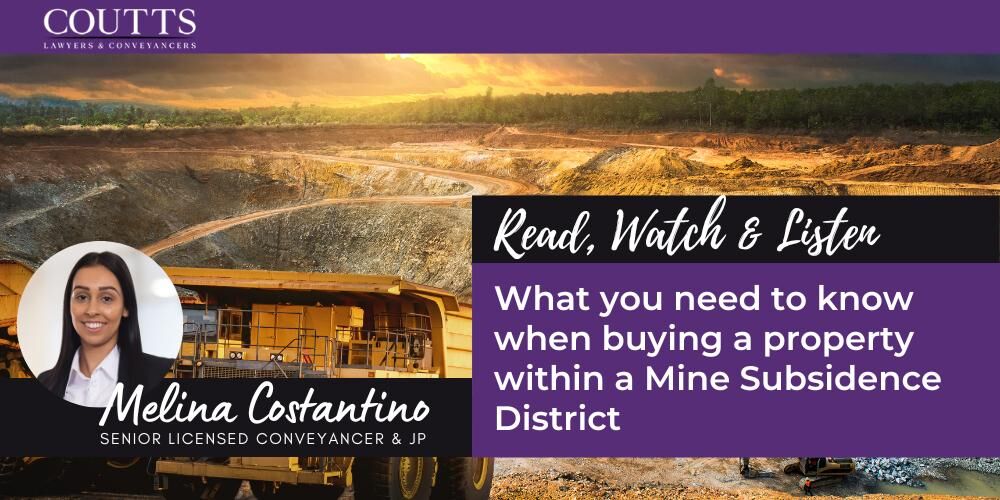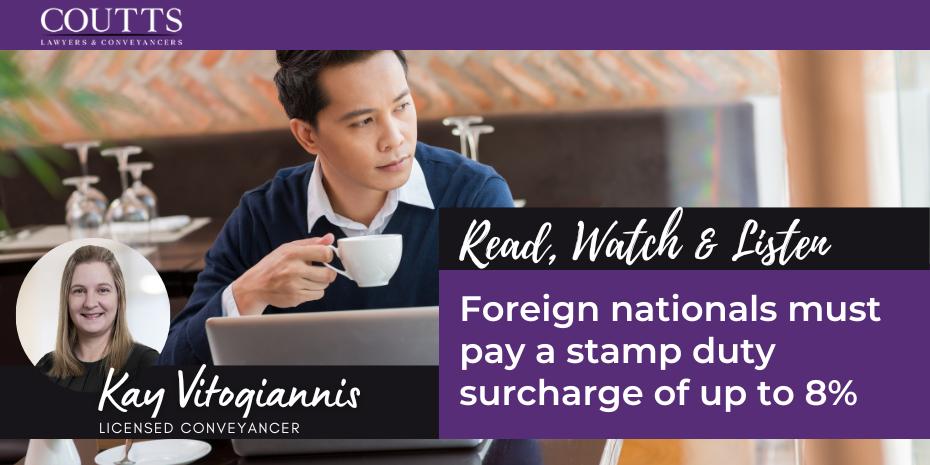KEY TAKE-OUTS:
- What is a Mine Subsidence District?
- What you need to know about purchasing a property in a Mine Subsidence District
What is a Mine Subsidence District?
A Mine Subsidence District is declared in areas where there are potential subsidence risks from active or non-active underground coal mining. ‘Subsidence’ relates to the sinking of the ground under the property which can result in, amongst other things, cracks and movement of the walls and floors to the structures on the land.
Can I build on land within a Mine Subsidence District?
Yes, subject to complying with development guidelines. The development guidelines applicable to properties within a Mine Subsidence District set out the requirements for building a dwelling and other structures on the land based on subsidence risks. Where the development guidelines are adhered to, property owners will be eligible for compensation should mine subsidence damage occur.
How do I know if the property I am purchasing is within a Mine Subsidence District?
This information is available in the Planning Certificate (also known as a 10.7 Certificate) which is available from Council and attached to every Contract for Sale. As such, your Solicitor or Conveyancer will be able to confirm whether the property you are looking to purchase is within a Mine Subsidence District once they have received and reviewed the Contract for Sale.
Alternatively, if you don’t have a copy of the Contract, you can find this information out via the NSW Planning Portal. You can also find out what development guidelines have been applied to the property via the Planning Portal.
I’m buying in a Mine Subsidence District – should I be concerned about my safety and/or damage to my property?
Subsidence Advisory records indicate that in the last 10 years, less than 2% of properties have been affected by subsidence. The fact that the property is mined beneath it, doesn’t mean it will be impacted by subsidence.
Usually, subsidence happens unnoticeably over a period of time as the ground beneath settles. Structures damaged by subsidence usually remain safe and can continue to be occupied while the claim is resolved and until the property is repaired.
In rare situations, the subsidence can result in small or big holes in the ground. These can be dangerous and must be treated with caution and reported immediately to Subsidence Advisory which runs a 24-hour emergency hotline.
What has changed?
Prior to 1 October 2019, a Purchaser could obtain a Section 15B and a Section 15C Certificate.
The Section 15B certificate confirmed that the property had been constructed in accordance with Subsidence Advisory’s development requirements and was eligible for compensation should the property suffer subsidence damage.
The Section 15C certificate identified if a claim for mine subsidence damage to a property had previously been paid or was pending. If a compensation claim for damage had already been paid, no further claims could be paid for the same damage, irrespective of whether repairs were completed.
From 1 October 2019, Subsidence Advisory stopped issuing the 15B and 15C Certificates.
The change came as a result of a comprehensive review of the mine subsidence compensation system which found that the process for assessing whether a property complied with Subsidence Advisory’s development requirements and was eligible for compensation was inadequate. The likelihood of a claim being made for a non-compliant property was extremely low and so the significant cost increase to adequately undertake compliance checks prior to issuing the certificates was deemed unjustifiable. For example, Subsidence Advisory’s records indicate that in the last 10 years, only 4 claims for homes have been refused due to the structure being non-compliant.
So what can I do as a Purchaser to ensure I would be entitled to make a claim in the event that a structure on the property was affected by Mine Subsidence?
- Make enquiries with the previous owner. Ask them whether they or any predecessors in title (owners before them) have made a claim and if so, request details of any previous claim including what works were completed or compensation paid.
- Search the Subsidence Advisory online register to see when the last 15B certificate was issued. Any structures on the property as of the date of issue of the 15B certificate are eligible for compensation should subsidence occur. However, any structures built, or structural alterations made after the issue of the certificate, must have been carried out in accordance with Subsidence Advisory’s requirements to be eligible for compensation.
- Make enquiries with Council to see what approvals they hold for structures erected on the property. Subsidence Advisory approval is required as part of the application process to the Council i.e. plans for any structure that is to be erected on land within a Mine Subsidence District will need to be approved by Subsidence Advisory NSW as well as the Local Council. As such, structures that have Council approval will be eligible for compensation should subsidence occur. Despite this, it is important to note that Council is not always able to confirm whether certain structures have approval due to factors like the age of the structures or lack of records held by Council.
Are there any protections in place for owners of property in a Mine Subsidence District where structures are non-compliant, but they were unaware of such non-compliance?
Subsidence Advisory has discretion to, under the Coal Mine Subsidence Compensation Act 2017, pay a claim for subsidence damage to an unapproved structure in circumstances where failure to obtain approval was not the fault of the property owner or where there are exceptional circumstances.
Subsidence Advisory may consider the claim if the property owner can establish that they exercised due diligence (see steps 1-3 above) and haven’t altered the unapproved structure.
What should I consider when I sell a property that is in a Mine Subsidence District?
It is recommended that you keep a copy of approvals to assist any future prospective purchaser when the property is listed for sale, and they start making enquiries.
What should I do if I have more questions or queries about purchasing in a Mine Subsidence District?
Contact the Subsidence Advisory NSW staff. They are available to address any questions or concerns you have about mine subsidence.
ABOUT MELINA COSTANTINO

Melina joined the Coutts team in 2010 working as a Licenced Conveyancer within our Property & Conveyancing team, based out of our Campbelltown office. Her commitment to client services saw her progress further and into the role of a Senior Licensed Conveyancer in July 2022.
She graduated with a distinction in the Advanced Diploma of Conveyancing and is accredited with the Australian Institute of Conveyancers NSW.
For further information please don’t hesitate to contact:
Melina Costantino
Senior Licensed Conveyancer & JP
info@couttslegal.com.au
1300 268 887
This blog is merely general and non-specific information on the subject matter and is not and should not be considered or relied on as legal advice. Coutts is not responsible for any cost, expense, loss or liability whatsoever in relation to this blog, including all or any reliance on this blog or use or application of this blog by you.



